Company of Heroes 2 Preview: Russian Attack
Relic's world-beating RTS turns its attention to the Eastern Front.
There are so many insane statistics about Russia's losses in World War II that the mind starts to bounce off them after a little while. Let's limit ourselves to just a single detail, then: one in seven Soviet citizens died in the course of the conflict. That offers some kind of insight, doesn't it? That allows you a decent handle on the fate of a nation blessed with such a talent for suffering that its strategy - for much of the early fighting at least - appears to have been to lose and lose and lose again, until there was nobody left standing for them to lose to any more.
Russia overwhelmed with numbers: with the sheer quantity of its often unskilled, frequently unarmed soldiers, and with the bizarre scale of the landscape its enemies would have to conquer. Russia endured because endurance was another talent. Was it triumphant? That really depends on the degree of elasticity you're willing to lend the word.
That one-in-seven stat came to England recently in the PowerPoint presentation of Quinn Duffy, the game director of Company of Heroes 2. For the RTS series' long-awaited sequel, the developers aren't reinventing or re-engineering from the ground up, and they aren't moving the game into an entirely new time period, laying on space marines or medieval trebuchets. Instead, Relic's shifting the focus to a different theatre of the same war. It's looking past the gritted glamour of Normandy to the mass-murder taking place on the Eastern Front.
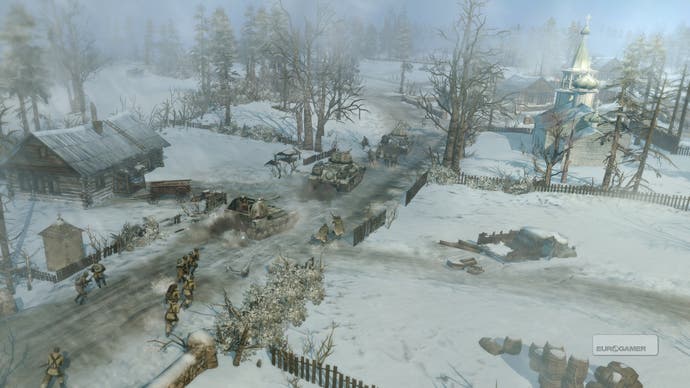
It's a good plan. Duffy admits that he was surprised to go back to the first game and discover that most of the events of Company of Heroes - from the D-Day landings and onwards - covered just four months out of a six-year war. Heading to Russia allows for a longer campaign - it was, after all, where Germany racked up 80 per cent of its combat casualties - and bigger, more complex battles. It offers a new, larger sandbox for the kind of close tactical warfare the series thrives on; a new scale of endurance and of suffering.
The mission the developer's showing off at the moment is a case in point. Rzhev Meatgrinder was fought in the winter of 1942 and was a battle that I'll admit I'd never even heard of before, even though it left one million Soviet troops dead. Demonstrating the 'ruthless truth of war' is one of the team's core concerns for Company of Heroes 2 - it's right there on a PowerPoint slide and everything. It's not the only concern, however. This particular bloodbath is also a chance to see how one of the best RTS games of all time - a game that's atypically focused on the human side of things - copes with one of the world's busiest, bloodiest conflicts.
First impressions, rather perversely, are that it's all surprisingly pretty, with the new game's Essence 3.0 engine coating the entire landscape in thick white unblemished snow. Volumetric and physics-based, this snow's not just there to make you feel Christmassy: it's part of the tactical challenge you'll face over the course of the game. It's laid thick across the maps and can be trampled down by tanks or slogged over by weary troops. It gives, and it takes away. You can hide behind banks of it if you're strapped for cover, perhaps, but moving through the stuff on foot is going to slow you down. Choices. Decisions. Tactics.
The snow's joined by the game's new True Sight system, which allows the player to see only what the men on the ground could make out from their vantage points. It's fog of war, in other words, but it's also far more exciting than you might expect. True Sight takes the form of a grey obscuring shadow that shifts around trees and blocks out entire clumps of the screen in real-time as you move your units from one piece of cover to the next. It comes together with the icy conditions to make for some truly monstrous challenges.
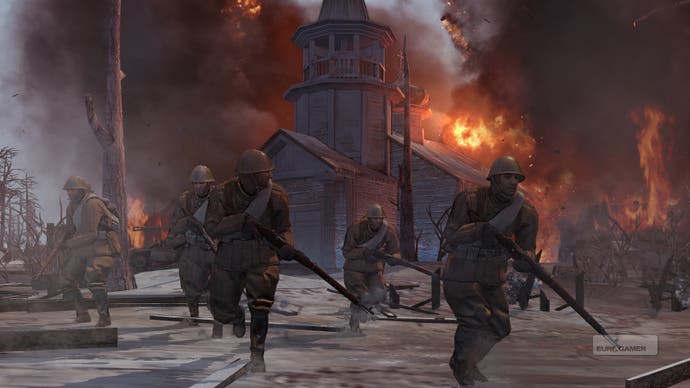
Challenges such as the very first leg of the demo mission, in which you move a squad of Russian troopers up towards an enemy-held farmhouse. There's a clear path you can take where the snow's compacted, so movement should be fairly quick. You'll be visible to the Germans from a distance, however, and will be easy pickings for artillery fire. Take to the deeper drifts, meanwhile, and you'll discover it hides your presence but is also studded with mines. The sight and sound of these going off - whittling your forces down in sudden bursts of light and noise - is genuinely shocking, a brief cone of smoke accompanied by a metallic thunderclap that will make you physically wince.
Head back? Not an option. As in the war, so in the game: in July 1942, Stalin issued Order 227, an infamous tide-turning proclamation that essentially meant any retreats, no matter how tactical, would result in the troops involved being killed by their own side. Regroup and face death by firing squad, death by cut-scene.
If you can make it past the farmhouse, you'll get to see other new tricks: a vaulting move that makes the game's already complex cover system a bit more flexible, and the game's latest tanks in the form of the Russian T-34. The T-34's a huge, terrifying proposition with great armour and firepower, but it's fairly horrible to steer, by the looks of things. Typical Russian engineering.
The tank's an asset, for sure, but it also presents a risk, since vehicle crews can now be taken out, allowing enemies to move in and turn your best equipment against you. It's a classic piece of Company of Heroes thinking: a vehicle that can also become a vicious flashpoint for impromptu battles as both sides try to recover a powerful strategic tool.
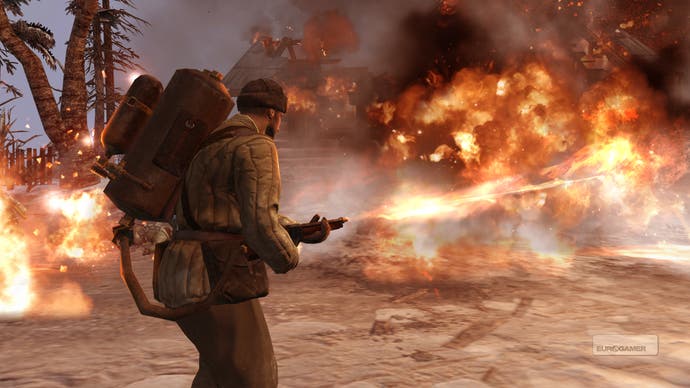
At least the T-34's impervious to everything except the German 88 gun: it's a unit that brings a hefty sense of charisma with it and lets history dictate the balancing. Throw it in alongside deformable terrain - buildings that can be set on fire by the game's new flamethrowers, low walls that won't withstand a well-placed mortar round - and you've got a dynamic battlefield where tactics will win the day and skirmishes can roll right across the huge map, chewing men up as they go.
That same dynamism can be found in Company of Heroes 2's asymmetrical factions: the blunt mass firepower of the Soviets, hammering away with little training but vast numbers, and the more professional, technical forces of Germans, who are skilled but outmanned, and perhaps unprepared for the harsh realities of a Russian winter.
The campaign, meanwhile, will take you from Operation Barbarossa through to Berlin itself, encapsulating not one but four different kinds of conflict, according to Duffy: a war of ideologies and a war of politics, a war of survival, and a war fought against nature itself - against the terrible cold, the horrible isolation.
There's the vaguest sense, inevitably, that there's something rather uncomfortable underpinning the whole experience. Nobody could doubt the sincerity of Relic's design team or its desire to shed a little more light on the awful events of the Eastern Front itself. Still, though, one generation's sacrifice becomes another's entertainment. Suffering, unlike snow physics, isn't something you should really approach volumetrically, but it's hard not to at times. The worse the scale of the misery, the harder it is to see it transformed into tight, tactical mechanics, and while all wars are horrible, this war seems to be almost grotesque, almost fantastical, in its reach and its grasp.
It's all balance, though. Company of Heroes rarely shies away from the worst of the fighting, and rarely loses itself, either, in shameful delight at all the gory details. It never airbrushes in Hollywood heroics like Call of Duty, and it never indulges in gristle porn close-ups like the most recent Brothers in Arms. If anyone was going to make the Eastern Front playable, in other words, it should probably be this team.
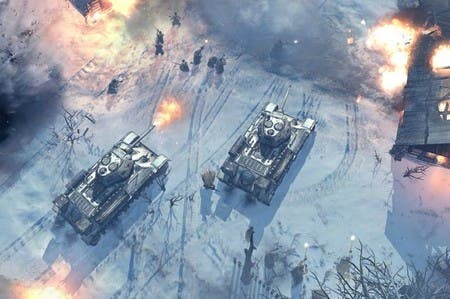

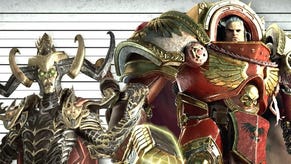
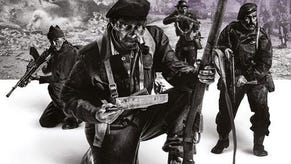
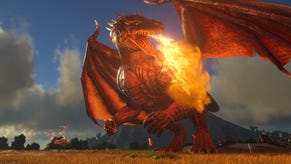
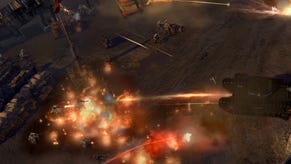
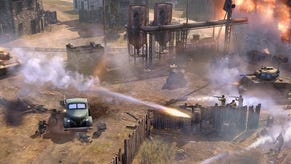


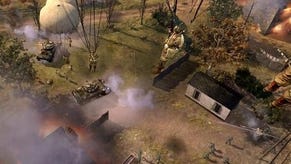

.png?width=291&height=164&fit=crop&quality=80&format=jpg&auto=webp)




.jpg?width=291&height=164&fit=crop&quality=80&format=jpg&auto=webp)
